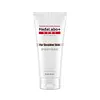What's inside
What's inside
 Key Ingredients
Key Ingredients

 Benefits
Benefits

 Concerns
Concerns

 Ingredients Side-by-side
Ingredients Side-by-side

Water
Skin ConditioningSodium Lauroamphoacetate
CleansingSodium Methyl Cocoyl Taurate
CleansingSodium Chloride
MaskingCocamidopropyl Betaine
CleansingSodium Cocoamphoacetate
CleansingHydroxypropyl Starch Phosphate
Citric Acid
BufferingStyrene/Acrylates Copolymer
Acrylates Copolymer
Glycerin
HumectantPhenoxyethanol
PreservativePotassium Hydroxide
BufferingChlorphenesin
AntimicrobialDisodium EDTA
Butylene Glycol
HumectantTranexamic Acid
AstringentSodium Hyaluronate
HumectantHydrolyzed Collagen
EmollientDipotassium Glycyrrhizate
HumectantAlpha-Glucan Oligosaccharide
CleansingPanax Ginseng Root Extract
EmollientHouttuynia Cordata Extract
Skin ConditioningGinkgo Biloba Leaf Extract
Skin ConditioningVaccinium Myrtillus Leaf Extract
AstringentWater, Sodium Lauroamphoacetate, Sodium Methyl Cocoyl Taurate, Sodium Chloride, Cocamidopropyl Betaine, Sodium Cocoamphoacetate, Hydroxypropyl Starch Phosphate, Citric Acid, Styrene/Acrylates Copolymer, Acrylates Copolymer, Glycerin, Phenoxyethanol, Potassium Hydroxide, Chlorphenesin, Disodium EDTA, Butylene Glycol, Tranexamic Acid, Sodium Hyaluronate, Hydrolyzed Collagen, Dipotassium Glycyrrhizate, Alpha-Glucan Oligosaccharide, Panax Ginseng Root Extract, Houttuynia Cordata Extract, Ginkgo Biloba Leaf Extract, Vaccinium Myrtillus Leaf Extract
Water
Skin ConditioningBabassu Oil Glycereth-8 Esters
EmulsifyingDisodium Cocoyl Glutamate
CleansingLauramidopropyl Hydroxysultaine
CleansingSodium Lauroyl Glycinate
CleansingGlycerin
HumectantEuterpe Oleracea Fruit Extract
Morinda Citrifolia Fruit Extract
Skin ConditioningPunica Granatum Fruit Juice
MaskingGarcinia Mangostana Fruit Extract
Skin ConditioningCoffea Arabica Seed Extract
MaskingCamellia Sinensis Leaf Extract
AntimicrobialLycium Barbarum Fruit Extract
AstringentSodium Chloride
MaskingSodium Laurate
CleansingSodium Lauroamphoacetate
CleansingStearamidoethyl Diethylamine
Phenoxyethanol
PreservativeParfum
MaskingEthylhexylglycerin
Skin ConditioningWater, Babassu Oil Glycereth-8 Esters, Disodium Cocoyl Glutamate, Lauramidopropyl Hydroxysultaine, Sodium Lauroyl Glycinate, Glycerin, Euterpe Oleracea Fruit Extract, Morinda Citrifolia Fruit Extract, Punica Granatum Fruit Juice, Garcinia Mangostana Fruit Extract, Coffea Arabica Seed Extract, Camellia Sinensis Leaf Extract, Lycium Barbarum Fruit Extract, Sodium Chloride, Sodium Laurate, Sodium Lauroamphoacetate, Stearamidoethyl Diethylamine, Phenoxyethanol, Parfum, Ethylhexylglycerin
 Reviews
Reviews

Ingredients Explained
These ingredients are found in both products.
Ingredients higher up in an ingredient list are typically present in a larger amount.
Glycerin is already naturally found in your skin. It helps moisturize and protect your skin.
A study from 2016 found glycerin to be more effective as a humectant than AHAs and hyaluronic acid.
As a humectant, it helps the skin stay hydrated by pulling moisture to your skin. The low molecular weight of glycerin allows it to pull moisture into the deeper layers of your skin.
Hydrated skin improves your skin barrier; Your skin barrier helps protect against irritants and bacteria.
Glycerin has also been found to have antimicrobial and antiviral properties. Due to these properties, glycerin is often used in wound and burn treatments.
In cosmetics, glycerin is usually derived from plants such as soybean or palm. However, it can also be sourced from animals, such as tallow or animal fat.
This ingredient is organic, colorless, odorless, and non-toxic.
Glycerin is the name for this ingredient in American English. British English uses Glycerol/Glycerine.
Learn more about GlycerinPhenoxyethanol is a preservative that has germicide, antimicrobial, and aromatic properties. Studies show that phenoxyethanol can prevent microbial growth. By itself, it has a scent that is similar to that of a rose.
It's often used in formulations along with Caprylyl Glycol to preserve the shelf life of products.
Chances are, you eat sodium chloride every day. Sodium Chloride is also known as table salt.
This ingredient has many purposes in skincare: thickener, emulsifier, and exfoliator.
You'll most likely find this ingredient in cleansers where it is used to create a gel-like texture. As an emulsifier, it also prevents ingredients from separating.
There is much debate on whether this ingredient is comedogenic. The short answer - comedogenic ratings don't tell the whole story. Learn more about comegodenic ratings here.
The concensus about this ingredient causing acne seems to be divided. Research is needed to understand if this ingredient does cause acne.
Scrubs may use salt as the primary exfoliating ingredient.
Learn more about Sodium ChlorideWe don't have a description for Sodium Lauroamphoacetate yet.
Water. It's the most common cosmetic ingredient of all. You'll usually see it at the top of ingredient lists, meaning that it makes up the largest part of the product.
So why is it so popular? Water most often acts as a solvent - this means that it helps dissolve other ingredients into the formulation.
You'll also recognize water as that liquid we all need to stay alive. If you see this, drink a glass of water. Stay hydrated!
Learn more about Water